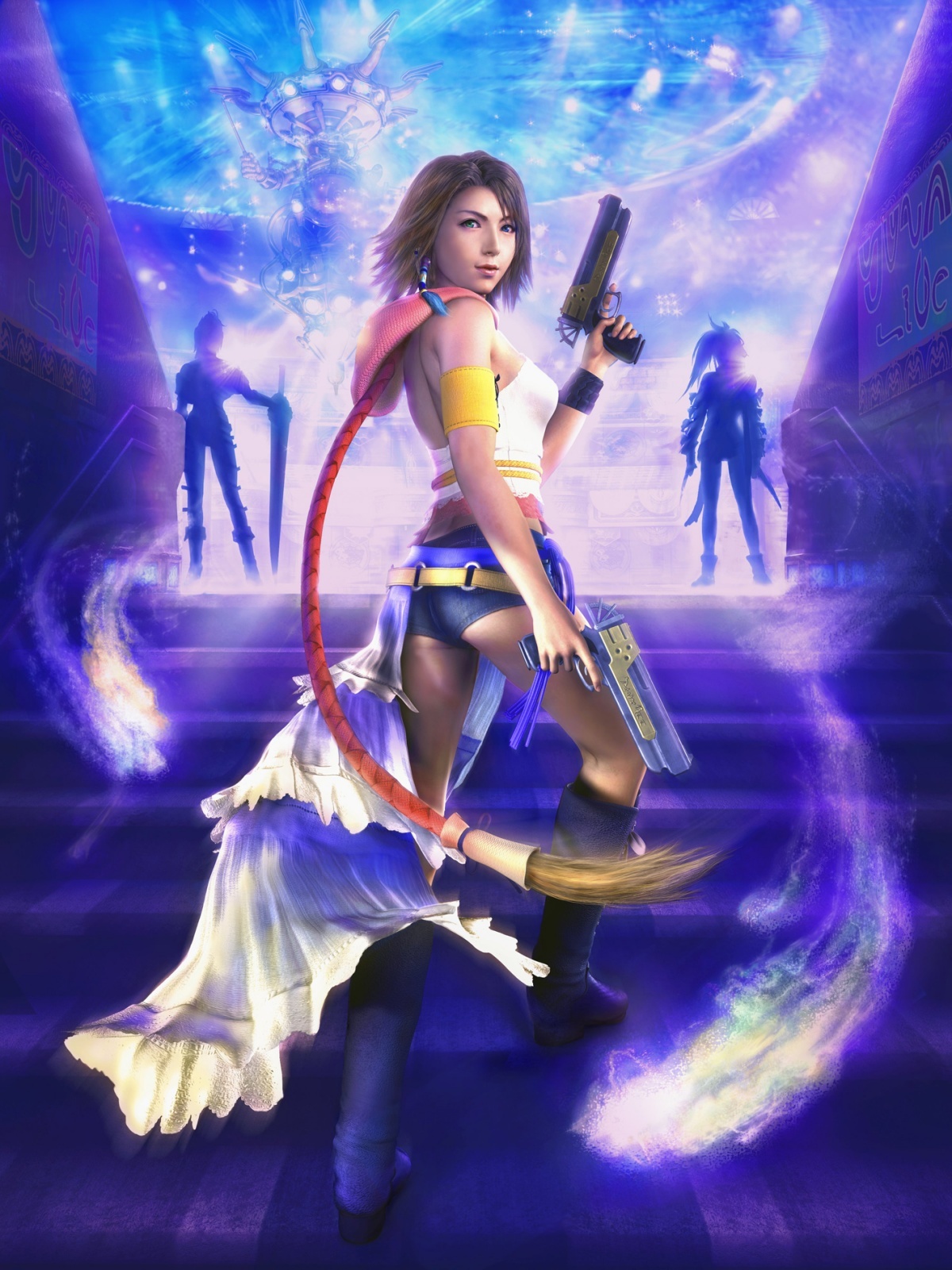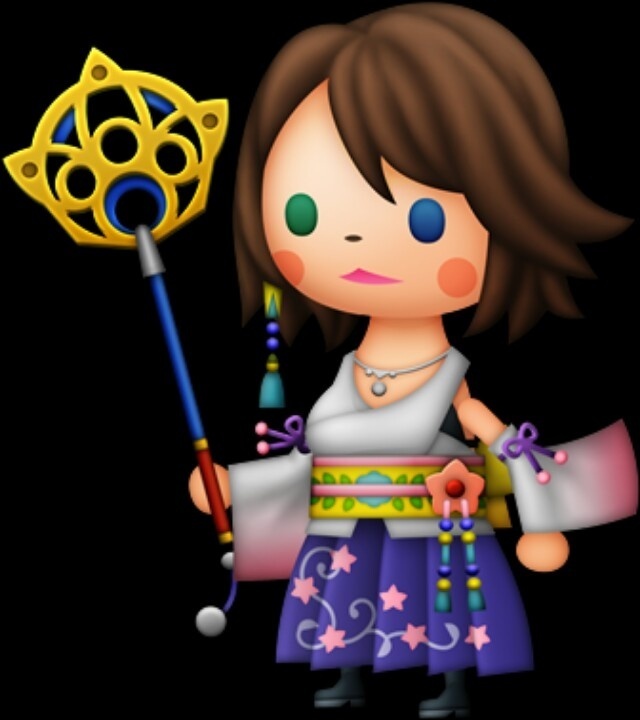Statistics
Age: 17 in Final Fantasy X, 19 in Final Fantasy X-2. That's right; she's technically a minor depending on where you live in the world during the first game. This is an easy mistake to make as she acts far more mature than expected.Species: Surprisingly, Yuna is not actually human but, rather, half human and half Al-Bhed. A race from her world noted for their blonde hair, spiral-shaped eyes, and apparent ability to hold their breath for prolonged periods of time. It is also possible that Yuna is, in fact, related to the Cetra from Final Fantasy VII (more on that later). If she is one of the Cetra ancestors, or merely related to them (or even connected to them), is unclear but not impossible regardless.
Location: First Bevelle, then Besaid Island, then on her own pilgrimage, before finally gaining her own airship. Home may simply not be a term that could apply to Yuna. Even when she resided in Besaid, she knew she was going to be leaving to engage on her summoning journey. However, Besaid is the closest thing she has to a home and the place she seems to relax in when not saving the world or hunting spheres, so that would likely be the closest thing to a proper 'home.'

Family Matters: Whooo boy. Yuna, as previously mentioned, is the daughter of two separate races. On her father's side, she is the child of High Summoner Braska, a human that had previously defeated the giant monster known as 'Sin.' Her mother is unnamed, but her uncle is Cid, a Final Fantasy mainstay. Additionally, she has at least two cousins in the form of Rikku and Brother. Brother has expressed some unsettling attractions to his cousin and, while it's obvious Yuna doesn't return the feelings, this does result in some uncomfortable scenes. However, the really interesting thing is her husband. See, in Final Fantasy X Yuna technically gets married to the game's antagonist, Seymour. While the marriage was most certainly annulled at the first chance possible, this does mean that, for a brief frame of time, she was married at age 17. To further complicate things, Seymour is, himself, a half-breed between humans and a race known as the 'Guado.' His human mother had also sacrificed herself to become the summoned spirit Anima, one summon that Yuna can learn in the game, meaning she's technically summoning her own mother-in-law. This is not to mention her romantic relationship with Tidus, which, in the 100% complete ending to X-2, is hinted at meaning Yuna, technically, has familial ties to humans, Al-Bhed, Guado, and the Fayth/summoned spirits.
Main Features: Honestly, it's hard to define. While in the first game she's the obvious White Mage/summoner, in the second game a lot changes. However her calm, hopeful, and kind attitude, capability with magic, and heterochomia eyes are easily the most immediately distinct features about her.
Clothing: Haha! Clothing for Yuna is near-impossible to describe. In Final Fantasy X she wore an outfit with a white top, detached sleeves, and light-blue/purple skirt that is very reminiscent of the Japanese priestess outfit. This outfit is very recognisable at even a glance, but the real problem comes from the second game and the dress-sphere mechanic. Namely that, with the dress spheres, Yuna's wardrobe is immense and almost always changing. Defining it is simply a futile task; however, the gunner outfit seems to be her preferred wardrobe with its white top with open middle, shorts, and literal half-skirt.
Concept
Yuna is, in a twist, actually the concept for Final Fantasy X instead of the other way around. Originally, the idea for the game's story was that a person, upon reaching the age of seventeen, would inevitably die. Oh hey, look, Yuna's 17! The game was meant to focus on the concept of inevitable death and the like, a fate that perfectly applies to Yuna in the first adventure. Yuna, then, in a twist, came before the journey itself and was basically responsible for how much of the world was shaped and designed. It really is her story and not that of Tidus. Much of her design in the first release was influenced by Japanese priestesses, with her clothes being an example obvious enough for even people not familiar with Japanese culture to catch on to. In the second title, the massive change in wardrobe was to help separate the two games more and show how Spira was evolving and changing.
Best Appearance:
It's no contest; Final Fantasy X is easily her best appearance. While she has appeared in other games besides the primary two, the only one in which a case for equal quality can really be made is Final Fantasy XIV and that was more her outfit than Yuna herself as optional purchasable content.
Do Not Mention:
Well, honestly, there isn't anything that really seems to make Yuna actually furious. The closest thing is her rejection of the false hope provided by the summoning rituals and her rejection of them, but otherwise there isn't anything that seems to make her mad. She was disgusted by Seymour upon finding out the truth and, considering he tried to kill her multiple times as a result, that may be the closest thing to a 'don't mention' for her.
Anything Else?
Yes; it's heavily implied that Final Fantasy VII and Final Fantasy X take place in the same world. In the second game, a character named Shinra notices what could easily be interpreted as the Lifestream of VII and even proposes tapping into it. It's unclear if he's actually related to Yuna or not, but it doesn't matter. While there is no strong evidence that Yuna is, in fact, an ancestor of Aerith, since summoners are the only ones capable of tapping into the powerful spirits and calming the souls of the dead and so-forth, if there is an ancestor to the Cetra in X it is almost certainly the summoners. If Yuna did end up with Tidus, this would mean probably the first (and only) relationship involving a spirit and mortal, further increasing the chances of Yuna at least being tied to the Cetra. However, there is nothing resembling concrete evidence and it's more of speculation.In the special 'Eternal Calm' both Yuna and Rikku have their appearances from the first game despite how it supposedly takes place right before the second adventure. This is because the development team didn't have models for the pair created in time resulting in a reused asset. At a certain point, a group of people offer to make a giant statue of Yuna with a giant horn on her head. This is a reference to the 'classic' summoner appearance in which they sported a piece of headwear with a singular horn.
In the Theatrythm titles, Yuna will summon up Bahamut, as opposed to Valefor, for her summoning sections. This is likely because the latter didn't exist prior to her adventure and has had limited appearances since. As Ixion was also created specifically for Final Fantasy X, this means Yuna has two unique summons in the series, which only she has access to. Additionally, Anima appeared first as a summon in this game for her, but would be featured more in future games.

 Sign In
Sign In 22.12.2017
22.12.2017 


 Snowtwo
Snowtwo 
 Link to this post:
Link to this post:  Subscribe to this topic
Subscribe to this topic Features
Features






 Top
Top

